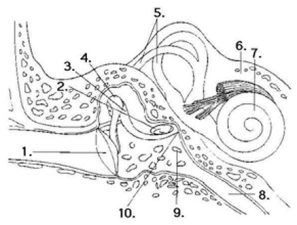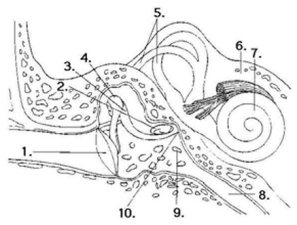A) hearing
B) smell
C) taste
D) touch
E) vision
G) B) and D)
Correct Answer

verified
Correct Answer
verified
Multiple Choice
Hair cells in the vertebrate ear are responsible for transducing sound pressure waves. Ion channels in the hair cell membrane open when ________.
A) a chemical ligand binds to the ion channel
B) light is absorbed by a molecule in the membrane
C) the cell membrane reaches a threshold voltage
D) the membrane is distorted mechanically
F) C) and D)
Correct Answer

verified
Correct Answer
verified
Multiple Choice
Partial or complete loss of hearing (deafness) can be caused by damage to the ________. I. axons of the neurons associated with each hair cell that carry information to the brain II. hair cells (the sensory receptors) in the cochlea III. tympanic membrane, or eardrum
A) only II
B) only III
C) only I and II
D) only II and III
E) I, II, and III
G) B) and E)
Correct Answer

verified
Correct Answer
verified
Multiple Choice
What structures would neurobiologists look for if they are interested in determining if an animal can see in color?
A) opsins
B) electroreceptors
C) pupil
D) lens
F) A) and B)
Correct Answer

verified
Correct Answer
verified
Multiple Choice
Two students studying physiology taste a known "bitter" substance. Student A reports sensing both a bitter taste and a salty taste, but student B reports only a salty taste. What is the most logical explanation?
A) Student A had an allergic reaction to the food, causing him to perceive the food as being bitter.
B) Student A has normal "bitter" taste buds; student B has defective "bitter" taste buds that result in lower sensitivity to bitterness.
C) Student A has a protein receptor capable of detecting a bitter molecule found in that substance, whereas student B lacks that particular protein receptor.
D) Student A has normal saliva, whereas student B's saliva is more alkaline than normal.
F) All of the above
Correct Answer

verified
Correct Answer
verified
Multiple Choice
The middle ear converts ________.
A) air pressure waves to fluid pressure waves
B) fluid pressure waves to air pressure waves
C) air pressure waves to nerve impulses
D) fluid pressure waves to nerve impulses
E) air pressure waves to hair cell movements
G) C) and D)
Correct Answer

verified
Correct Answer
verified
Multiple Choice
External chemical signals that coordinate potential reproductive partners are called ________.
A) hormones
B) pheromones
C) paracrine signals
D) cytokines
E) gametes
G) A) and B)
Correct Answer

verified
Correct Answer
verified
Multiple Choice
Which of the following would explain why a person was able to hear only high-frequency sounds?
A) The tympanum is damaged because of chronic ear infections.
B) The basilar membrane is stiffened along its entire length.
C) The ear ossicles are abnormally thickened.
D) All of these problems could result in inability to detect low-frequency sound.
F) C) and D)
Correct Answer

verified
Correct Answer
verified
Multiple Choice
The transduction of sound waves into action potentials by the human ear takes place ________.
A) within the tectorial membrane as it is stimulated by the hair cells
B) when hair cells are bent against the tectorial membrane, causing them to depolarize and release neurotransmitter that stimulates sensory neurons
C) as the basilar membrane becomes more permeable to sodium ions and depolarizes, initiating an action potential in a sensory neuron
D) as the basilar membrane vibrates at different frequencies in response to the varying volume of sounds
E) within the middle ear as the vibrations are amplified by the malleus, incus, and stapes
G) A) and C)
Correct Answer

verified
Correct Answer
verified
Multiple Choice
The cochlea ________. I. amplifies sound vibrations II. collects sound pressure waves III. detects the frequency of sounds
A) only I
B) only II
C) only III
D) only II and III
E) I, II, and III
G) B) and E)
Correct Answer

verified
Correct Answer
verified
Multiple Choice
The umami receptor in the sense of taste detects ________.
A) glucose
B) sodium ions
C) potassium ions
D) hydrogen ions
E) the amino acid glutamate
G) A) and D)
Correct Answer

verified
Correct Answer
verified
Multiple Choice
Refer to the accompanying diagram of the ear to answer the question(s) below.  -The structure involved in equalizing the pressure between the ear and the atmosphere is represented by which number?
-The structure involved in equalizing the pressure between the ear and the atmosphere is represented by which number?
A) 7
B) 1
C) 8
D) 9
E) 10
G) A) and D)
Correct Answer

verified
Correct Answer
verified
Multiple Choice
It can be very difficult to select an angle for sneaking up to a grasshopper to catch it because grasshoppers have ________.
A) excellent hearing for detecting predators
B) compound eyes with multiple ommatidia
C) eyes with multiple fovea
D) a camera-like eye with multiple fovea
E) binocular vision
G) C) and D)
Correct Answer

verified
Correct Answer
verified
Multiple Choice
The ampullae of Lorenzini in sharks are used for ________.
A) mechanoreception
B) thermoreception
C) electroreception
D) magnetoreception
E) photoreception
G) None of the above
Correct Answer

verified
Correct Answer
verified
Multiple Choice
How would an abnormally large oval window in a mouse affect that animal's hearing?
A) The mouse could detect noise at much lower volumes.
B) The mouse could detect noise in a much broader range of frequencies.
C) Hearing ability would be reduced in comparison with normal mice.
D) Hearing is not affected by the size of the oval window.
F) C) and D)
Correct Answer

verified
Correct Answer
verified
Multiple Choice
Deafness caused by loud sounds often results from damage to which receptor cells?
A) thermoreceptors
B) mechanoreceptors
C) chemoreceptors
D) electroreceptors
E) nociceptors
G) B) and C)
Correct Answer

verified
Correct Answer
verified
Multiple Choice
Refer to this diagram of the ear to answer the question(s) below.  -Hair cells are found in structures represented by which numbers?
-Hair cells are found in structures represented by which numbers?
A) 1 and 2
B) 3 and 4
C) 5 and 7
D) 6 and 8
E) 9 and 10
G) C) and D)
Correct Answer

verified
Correct Answer
verified
Multiple Choice
Animals that can detect ultraviolet (UV) light differ from humans by having ________.
A) larger eyes that can collect more UV light
B) UV-specific opsins that extend their visible light spectrum
C) thicker retinas that can capture UV light more efficiently
D) additional visual sensors to allow detection of different light types
F) B) and C)
Correct Answer

verified
Correct Answer
verified
Multiple Choice
Most mammals have 1000 or more genes that encode receptor proteins on the surface of odor-receptor neurons, so why do some mammals have a better sense of smell than others?
A) Some of the genes actively transcribing receptor proteins in some species are completely absent in other species.
B) Some of the genes that code for receptor proteins may have been mutated and rendered inactive in some species but not in others.
C) Some species, particularly humans, rely much less on odor detection for survival; thus, the genes have mutated to encode proteins that aid in other senses, such as sight.
D) Some species of mammals have a larger set of "basic odors" than other species.
F) A) and B)
Correct Answer

verified
Correct Answer
verified
Multiple Choice
What would happen if an enzyme inhibitor for the enzyme phosphodiesterase (PDE) was applied to a vertebrate eye?
A) The opsins found in cones would not be differentiated into the red, blue, and green proteins, causing the animals to be color blind.
B) The cGMP-gated sodium channels would remain open, glutamate would be continuously discharged at the synapses, and the brain would not detect light absorbed by the rod cells.
C) The lens could not be appropriately adjusted to focus light on the retina, resulting in either nearsightedness or farsightedness.
D) All of the listed responses are correct.
F) C) and D)
Correct Answer

verified
Correct Answer
verified
Showing 21 - 40 of 50
Related Exams